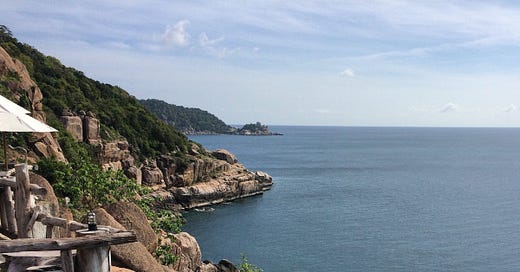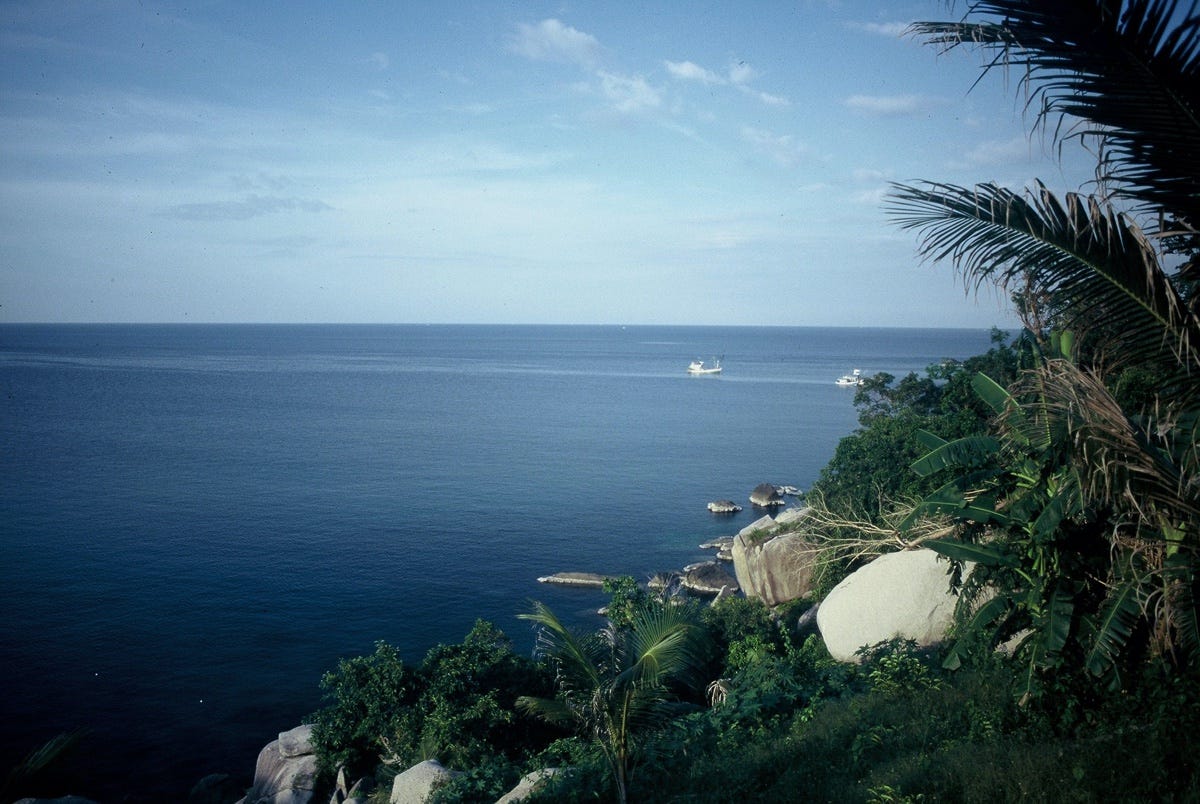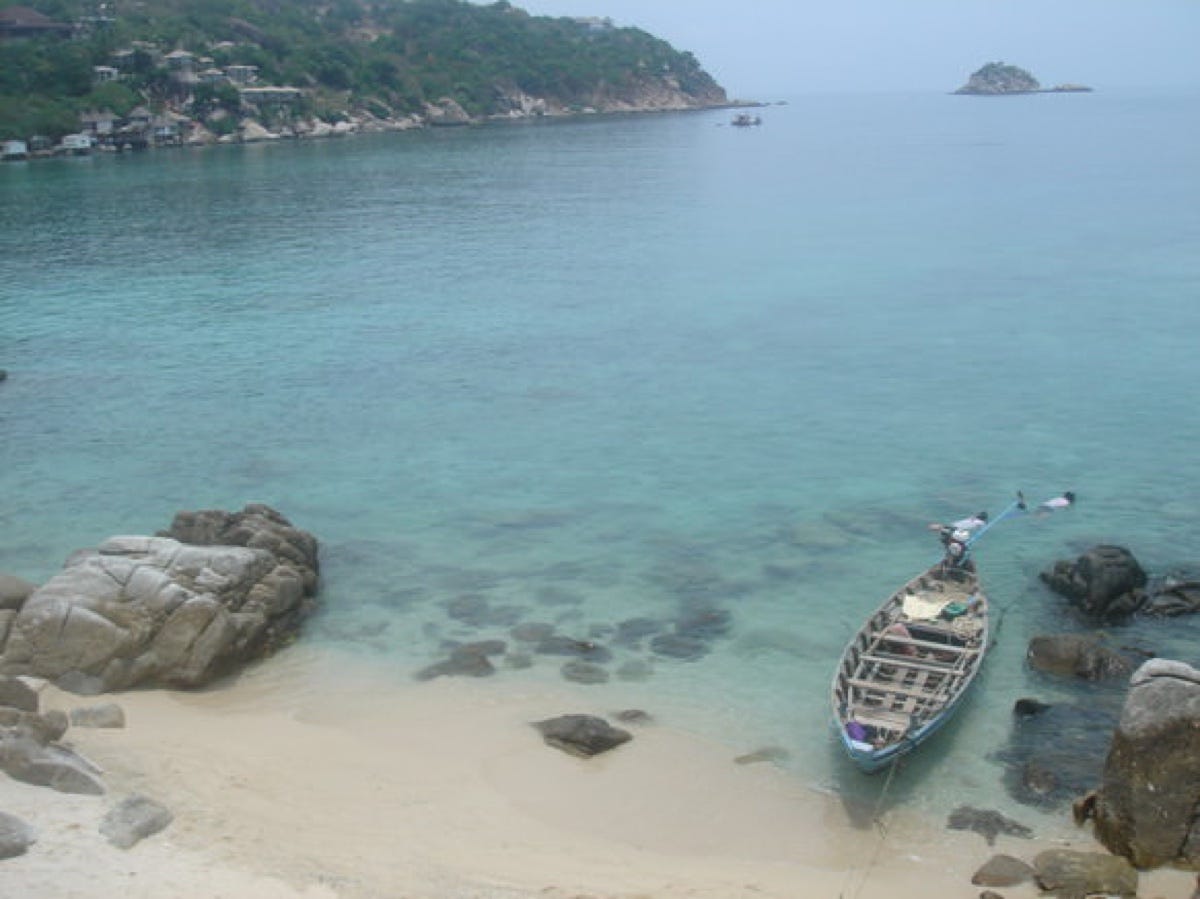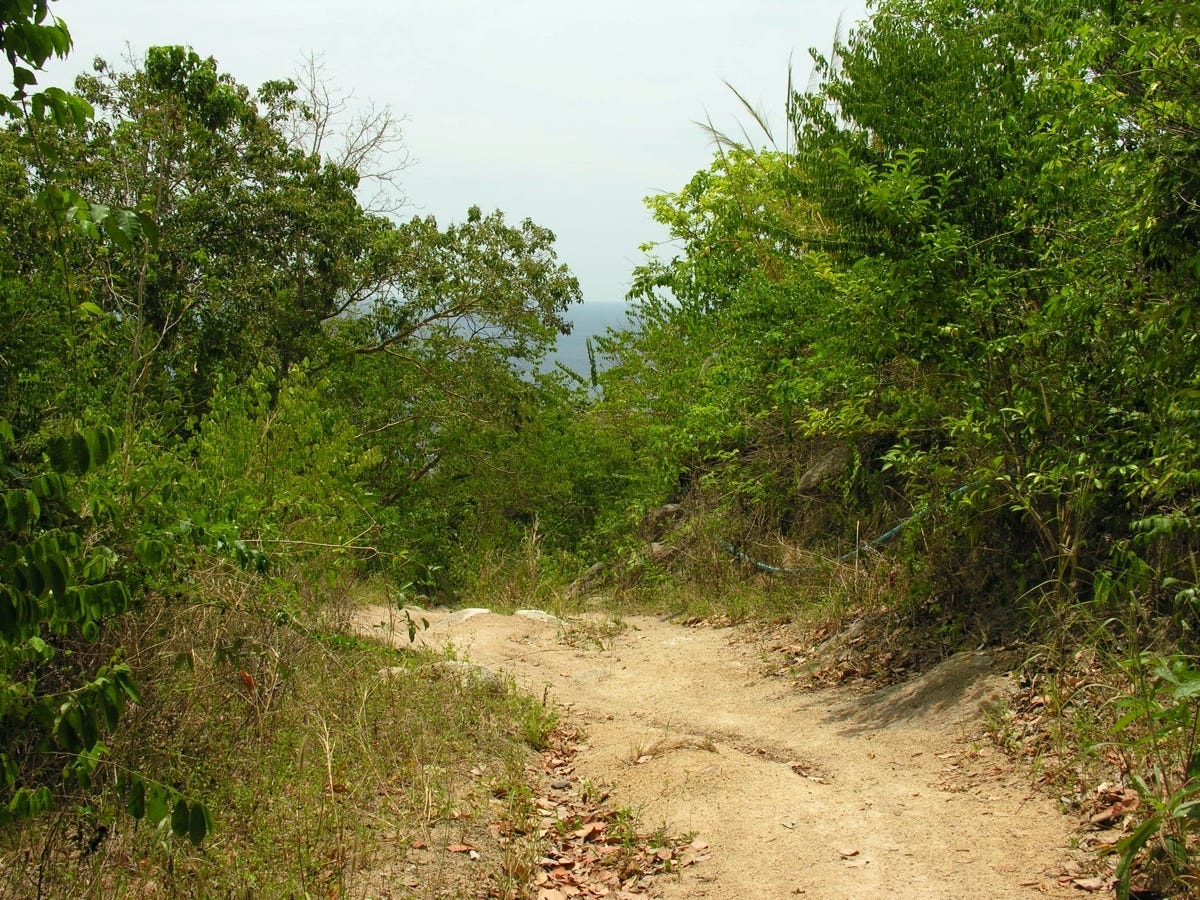The first time I went to Ko Tao in the Gulf of Thailand was in the early 1990s. It wasn’t a very successful visit. I didn’t dive at the time and was just looking for a quiet island. It turned out to be quieter than I planned.
A day after we arrived, the weather turned unseasonably ugly. Ugly. At the time there were no flash Lomprayah catamarans, rather the ferries were old and not great. The night boat was a notorious shocker. The boats stopped running. They wouldn’t recommence for at least a week. Thank god there was no social media then—I might have panicked.
Ko Tao’s east coast—no shortage of places to hideout. Photo: Stuart McDonald.
My partner and I had checked into a little beach hut joint at the northern end of Mae Haad. I can’t remember the name of it, but if you know Ko Tao, it was right before the hill that separates Mae Haad from Haad Sairee. The huts were simple rattan–walled, wood–framed, palm frond–roofed jobs. A squat loo was out back and the amenities extended to a mosquito net and an oil lamp for when the generator went off. As with the name, I don’t recall the price, but it wouldn’t have been much—100 baht a night maybe.
Before the weather turned, it was a fun time. The water was twenty metres away and we’d get up, stagger to the sea and fall in. Almost all our meals were at the dinky little restaurant on site. On the first night we strolled to a Mom and Pop seafood place over the water in Mae Haad. Adventurous.
Then the weather turned.
Simpler times. Photo: Stuart McDonald.
Over the next week we got to know the confines of our bungalow and the onsite restaurant well. I don’t know if I’ve ever eaten as many no–names in the same period since. We got sick. The staff were sick. There were only two other guests, two British women, but we hardly ever saw them. The bungalow staff kept telling us they were “sicker than the rest of us”. When one finally surfaced she was as thin as a rake, out of money and said her friend had cholera. I recoil even now typing that, almost thirty years later.
I don’t know if she actually had cholera, but that’s what her friend said—and they both looked like death warmed up. They were on the first boat out. We waited for the second one.
Pretty at a glance … Photo: Stuart McDonald.
The next year I returned to the island with my partner of the time. Neither of us dove but she was a keen free diver. We headed to a spot on the back of the island known for bouldering and snorkelling. It was glorious.
We went for a week, stayed six, and neither of us caught cholera.
The roads over the island were a joke then, so you’d catch a long tail from the pier at Mae Haad around to the far side. It was the perfect decompress from the ferry ride. The long tail would rock with the swell around the north side of “Turtle Island” before ducking into your bay of choice. Depending on the bay, a gaggle of huts would run up the ridge or be low slung by the water’s edge.
But it pays to read the small print. Photo: Stuart McDonald.
The guesthouse owners were colourful to say the least.
One, back in his teens, had allegedly killed a guy in Bangkok in a knife fight. He’d show you his scars after enough bongs and Thai whiskey. After the fight, he fled to Ko Tao and had been there ever since.
“You should see the other guy,” he’d growl in a well-rehearsed line.
Another had a sideline in smuggling. She’d pay backpackers to carry precious stones on flights between Colombo and Bangkok. “Free holiday to Sri Lanka” was how she sold it. We passed.
Pirates welcome. Photo: Stuart McDonald.
One place had the foundations of a hut at the centre of the property. The story goes a backpacker, smoking in bed, set his mosquito net on fire. Side note here, this is a very serious risk—never smoke under a mozzie net. The hut burnt to the ground and when the owner asked him to pay for the damage, the backpacker cried poor boy. The figure of 10,000 baht sticks in my mind, but I could be wrong.
Regardless of the amount, the owner agreed to let him go to the mainland to get the money (there were no ATMs on Ko Tao then). Quell surprise, he never returned. The foundations stood untouched. When I returned to the place in 2018, they were still there. “He’s still not come back, maybe next year,” the owner laughed from his lazy chair as we shot the breeze.
There was another place elsewhere on the island—island folk—born on the island. As with many islands, it doesn’t matter how long you spend there, you were either born on the island or you weren’t. You can’t fake it—and when push comes to shove it matters.
Roads have improved a it. Photo: David Luekens.
Her place was notorious for petty theft, but it sat very close to a drop dead gorgeous beach. It was, in all aspects a terrible place—don’t be fooled by the “resort” suffix—but the punters kept coming. The thefts kept happening. A little money here, a camera there. Trekking boots or a sleeping bag would vanish.
Returning from a night out, a guest walked into his bungalow to find staff riffling through his gear. Words were exchanged. The owner and her husband (also an island person and crazy as a cut snake) appeared. Things heated up. A door got kicked in and a knife got pulled. The backpacker lost everything—they marched him out of the “resort”, gave him 100 baht of his own money back, and told him to get lost.
The next day he reported what had happened to a police officer. When they found out the resort, they refused to even take a report.
It is best to keep your distance. Photo: Stuart McDonald.
Being born on the island matters.
Decades passed. In recent years, Ko Tao has earned an unsavoury reputation thanks to ghastly murders and mysterious deaths. The tabloid press, and even the New York Times, has labelled it “Death Island”. Ironic for an island that kicked off as a political prison in 1943.
When I was there in 2018, I lost an afternoon at a beach bar chatting with one of the children of the knife fighter who fled to Ko Tao. I asked them what they thought of what the island had become.
Is the sun setting on a classic Thai destination? Photo: Stuart McDonald.
“I never go over there anymore,” they said (referring to the more developed side of the island). “Greedy and stupid people, almost nobody is from here. Just about money. They don’t understand Ko Tao—they’ll kill it.”
Following their lead, I asked about the killings.
“Everyone knows who did it, but they were born here, so nothing will happen.”
I asked were they born on the island?
“I was born there,” they said, pointing to a patch of grass below the restaurant.





















Share this post